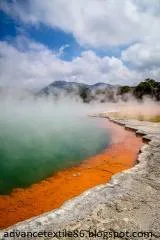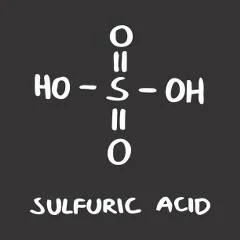Sulfuric Acid
Organic name- Sulfuric Acid (American) or
Sulphuric Acid (British)
Molecular formula – H2SO4
Strength – Very Strong Acid
Sulfuric
acid also known as vitriol oil, is a mineral acid composed of the molecular
formula H2SO4 with sulfur, oxygen, and hydrogen
components. It is a colorless, odorless, and smooth liquid that is soluble in
water and synthesized in a reaction that is highly external.
Sulphuric Acid formation
Pure
sulfuric acid is not found naturally on earth in the form of anhydrous because
of its extreme affection for water. Dilute sulfuric acid is a component of
precipitation that is formed by atmospheric oxidation of sulfur dioxide in the
presence of water - i.e. oxidation of sulfuric acid. Sulfur dioxide is the main
by-product when sulfur-containing fuels, such as coal or oil, are burned.
Sulfuric
acid is naturally formed by the oxidation of sulfide minerals such as iron
sulfide. For this reason, water can be highly acidic and is called acid mine
drainage (AMD) or acid rock drainage (ARD). This acidic water is able to
dissolve the metals present in the sulfide ores, resulting in a brightly
colored, toxic solution.
The first step is to burn sulfur to make sulfur dioxide.
S
(s) + O2 → SO2
Sulfur dioxide is oxidized to sulfur trioxide by oxygen in the presence of the
vanadium (V) oxide catalyst. This reaction is the opposite and the formation of
sulfur trioxide is extrinsic.
2
SO2 + O2 ⇌
2 SO3
Sulfur
trioxide is absorbed in the formation of oleum (H2S2O7)
in 97-98% H2SO4, also known as sulfuric acid fumigation.
Oleum then mixes with water to form a concentrated sulfuric acid.
H2SO4
+ SO3 → H2S2O7
H2S2O7
+ H2O → 2 H2SO4
Directly
dissolving SO3 in water is not practiced.
Properties of sulphuric acid
i.
Although nearly 100% of sulfuric acid solutions can be made storage
concentration is 98.3%.
ii.
10M sulfuric acid is prepared by slowly adding 98% sulfuric acid to an equal volume of water, with good stirring, the temperature of the mixture can rise to
80 °C or higher.
iii.
Pure sulfuric acid has a vapor pressure of <0.001 mmHg at 25 °C and 1 mmHg
at 145.8 °C.
iv.
Pure sulfuric acid is a viscous clear liquid, like oil, and this explains the old name of the acid.
v.
Commercial sulfuric acid is sold in several different purity grades. Technical
grade H2SO4 is impure and often colored but is suitable for making fertilizer.
Pure grades, such as United States Pharmacopeia (USP) grade, are used for
making pharmaceuticals and dyestuffs. Analytical grades are also available.
vi.
Melting point 10.31°C and boiling point 337°C.
vii.
It is a clear, colorless, and odorless liquid.
viii.
It is a non-flammable chemical
You may know- Synthetic fibers | What are the properties of synthetic fiber?
ix.
It reacts with most bases to give the sulfate salt and water.
x.
The hydration reaction of sulfuric acid is highly exothermic.
xi.
It reacts with its anhydride, SO3, to form H2S2O7 and it is called pyrosulfuric
acid or fuming sulfuric acid.
xii.
Anhydrous H2SO4 is a polar liquid with a dielectric constant of about 100.
xiii.
It attacks reactive metals like iron, aluminum, zinc, manganese, magnesium, and nickel and produces hydrogen gas and its salts.
Reaction with Water
Since
the hydration reaction of sulfuric acid is highly exothermic, it should always
be reduced by adding acid to water rather than acid. Because the reaction is a
balance that supports the rapid persuasion of water, the addition of acid to
the water ensures that the acid is a limiting reagent. This reaction is best
understood as the formation of hydronium ions:
H2SO4
+ H2O → H3O+ + HSO4- Ka1 ≈ 103 (strong acid)
HSO4-
+ H2O → H3O+ + SO42- Ka2
= 1.0×10−2
HSO4-
is a bisulfate anion and SO42- is a sulfate anion. Ka1
and Ka2 are the acid dissociation constants.
Sulfuric acid uses in industry
i.
Most of the amount of sulfuric acid is used for industrial purposes.
ii.
About 60% of the amount is consumed for fertilizers, especially
superphosphates, ammonium phosphate, and ammonium sulfate.
iii.
About 20% of sulfuric acid is used in the different chemical industries for the
production of products like detergents, synthetic resins, dyestuffs,
pharmaceuticals, petroleum catalysts, insecticides, and antifreeze.
iv.
It is used for about 6% are related to pigments including paints, enamels, printing
inks, coated fabrics, papers, and others.
v.
It is widely used by the iron and steel-making industry to remove corrosion,
rust, and scaling from rolled sheets and billets before their sale in the
automobile and major equipment industries.
vi.
High-concentration sulfuric acid is often the main ingredient in acidic drain
cleaners used to remove grease, hair, tissue paper, etc.
Safety
Sulfuric
acid is capable of causing extremely intense combustion, especially when it is
of high concentration. Common with other corrosive acids and alkalis, it easily
decomposes proteins and lipids through amide and ester hydrolysis after contact
with living tissues such as skin and flesh.











0 Comments